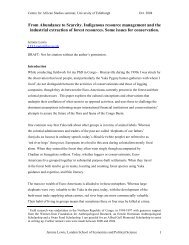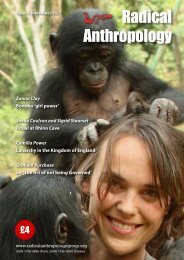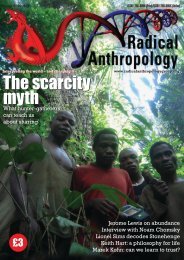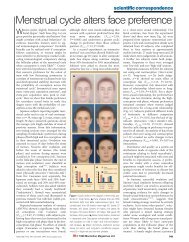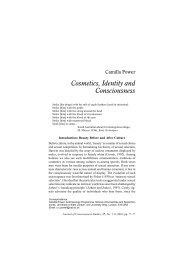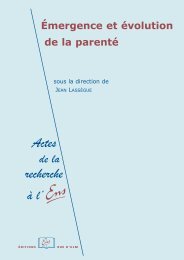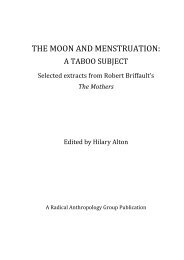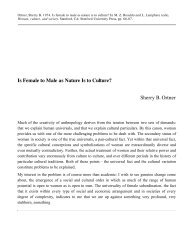Commentary/Locke & Bogin: <str<strong>on</strong>g>Language</str<strong>on</strong>g> <str<strong>on</strong>g>and</str<strong>on</strong>g> <str<strong>on</strong>g>life</str<strong>on</strong>g> <str<strong>on</strong>g>history</str<strong>on</strong>g>to have evolved a specific tendency to use elaborate vocalizati<strong>on</strong> as ameans of soliciting l<strong>on</strong>g-term investment from caregivers. The<strong>development</strong> of such vocal capacity provides necessary infrastructurefor language <strong>development</strong> across human <str<strong>on</strong>g>life</str<strong>on</strong>g> <str<strong>on</strong>g>history</str<strong>on</strong>g>.By highlighting <strong>the</strong> unique human <str<strong>on</strong>g>life</str<strong>on</strong>g> <str<strong>on</strong>g>history</str<strong>on</strong>g>, Locke & Bogin(L&B) bring into focus <strong>the</strong> need to address <strong>development</strong> in modeling<strong>the</strong> evoluti<strong>on</strong> of language. Although <strong>the</strong> emphasis in <strong>the</strong>target article is <strong>on</strong> stages spanning birth through adolescence,it also bears emphasizing that even in <strong>the</strong> first six m<strong>on</strong>ths ofhuman <str<strong>on</strong>g>life</str<strong>on</strong>g>, vocal <strong>development</strong> is remarkable, <str<strong>on</strong>g>and</str<strong>on</strong>g> appears tobring <strong>the</strong> infant to a point of functi<strong>on</strong>al <str<strong>on</strong>g>and</str<strong>on</strong>g> c<strong>on</strong>textual flexibilityin producti<strong>on</strong> <str<strong>on</strong>g>and</str<strong>on</strong>g> use of vocalizati<strong>on</strong> that is never achieved in anyn<strong>on</strong>human primate (Oller & Griebel 2005). The foundati<strong>on</strong>s laidin <strong>the</strong> first six m<strong>on</strong>ths appear to be critical to all subsequent<strong>development</strong> toward vocal language, because it would be impossibleto learn even <strong>the</strong> simplest group-specific words or even toproduce systematic imitati<strong>on</strong> of novel syllable patterns in <strong>the</strong>absence of substantial functi<strong>on</strong>al <str<strong>on</strong>g>and</str<strong>on</strong>g> c<strong>on</strong>textual flexibility ofvocalizati<strong>on</strong>. Similarly, it is sensible to c<strong>on</strong>clude that ourhominid ancestors, as <strong>the</strong>y broke away from <strong>the</strong> primate background,prior to possessing language must have developedcomm<str<strong>on</strong>g>and</str<strong>on</strong>g> of vocal flexibility, because, without it, all fur<strong>the</strong>revoluti<strong>on</strong> in <strong>the</strong> directi<strong>on</strong> of vocal language may well have beenimpossible.This evoluti<strong>on</strong>ary process must have been <strong>the</strong> product ofspecific selecti<strong>on</strong> forces, just as <strong>the</strong>re appear to have beenspecial selecti<strong>on</strong> forces that have produced vocal variability <str<strong>on</strong>g>and</str<strong>on</strong>g>flexibility in o<strong>the</strong>r species with complex communicati<strong>on</strong>systems, especially some cetaceans <str<strong>on</strong>g>and</str<strong>on</strong>g> birds (Griebel & Oller,in press). Interestingly, <strong>the</strong>re are more than 200 extant speciesof primates (Martin 1990) but <strong>on</strong>ly <strong>the</strong> human shows vast vocalflexibility, suggesting that primate <str<strong>on</strong>g>life</str<strong>on</strong>g> circumstances have overwhelminglyfavored vocal systems serving specific, immediatefuncti<strong>on</strong>al needs such as aggressi<strong>on</strong>, distress, or alarm signaling,<str<strong>on</strong>g>and</str<strong>on</strong>g> to serving those needs with well-defined, unambiguous calls(Griebel & Oller, in press; Hauser 1996). One of <strong>the</strong> most fundamentalquesti<strong>on</strong>s of language evoluti<strong>on</strong> <strong>the</strong>n is: What was uniqueabout hominid <str<strong>on</strong>g>life</str<strong>on</strong>g> circumstances that yielded selecti<strong>on</strong> forceswhere hominids <str<strong>on</strong>g>and</str<strong>on</strong>g> <strong>on</strong>ly hominids came to possess vocalcapacities that vastly exceeded <strong>the</strong> requirements of immediatefuncti<strong>on</strong>al needs?The pattern of modern human <strong>development</strong> in <strong>the</strong> first sixm<strong>on</strong>ths of <str<strong>on</strong>g>life</str<strong>on</strong>g> suggests an answer. The human infant is morealtricial <str<strong>on</strong>g>and</str<strong>on</strong>g> faces a l<strong>on</strong>ger immaturity than any o<strong>the</strong>r primate,as is emphasized in <strong>the</strong> target article. C<strong>on</strong>sequently, <strong>the</strong> humaninfant has a need for l<strong>on</strong>g-term caregiver investment that dramaticallyexceeds that of any o<strong>the</strong>r primate. The unique topography<str<strong>on</strong>g>and</str<strong>on</strong>g> richness of human parent-infant face-to-face vocalinteracti<strong>on</strong>s str<strong>on</strong>gly suggests b<strong>on</strong>ding is at stake (see, e.g.,Stern 1974; Trevar<strong>the</strong>n 1979; Tr<strong>on</strong>ick 1982), <str<strong>on</strong>g>and</str<strong>on</strong>g> that elaborate,c<strong>on</strong>textually flexible infant vocalizati<strong>on</strong> solicits parental investment(Oller 2000). Parents appear to distill fitness informati<strong>on</strong>from infant vocalizati<strong>on</strong>, <str<strong>on</strong>g>and</str<strong>on</strong>g> in many instances to elicit it inface-to-face interacti<strong>on</strong>, presumably because it benefits parentsto make wise decisi<strong>on</strong>s about investment of energies in infantsfacing a l<strong>on</strong>g immaturity (Locke, in press c; Oller 2004).Human caregivers also attend to a variety of infant vocalizati<strong>on</strong>soutside b<strong>on</strong>ding interacti<strong>on</strong>s.Vocalizati<strong>on</strong> in <strong>the</strong> human infant is <strong>the</strong>n a fitness indicator,providing evidence to caregiving kin about infant well-being.Because <strong>the</strong> premium <strong>on</strong> l<strong>on</strong>g-term investment by caregivers ishigher for <strong>the</strong> human infant than for any o<strong>the</strong>r primate, <strong>the</strong> selecti<strong>on</strong>pressure <strong>on</strong> infant fitness indicators is also higher than forany o<strong>the</strong>r primate. And since altriciality had already increasedin hominids by <strong>the</strong> point of bipedalism, intense selecti<strong>on</strong>pressure <strong>on</strong> infant solicitati<strong>on</strong> of parental investment must havebeen in place very early in hominid evoluti<strong>on</strong>. The pattern ofvocal <strong>development</strong> in <strong>the</strong> human infant suggests, <strong>the</strong>n, that <strong>the</strong>driving engine of evoluti<strong>on</strong> for hominid vocal capacity mayhave been <strong>the</strong> unique c<strong>on</strong>stellati<strong>on</strong> of <str<strong>on</strong>g>life</str<strong>on</strong>g> <str<strong>on</strong>g>history</str<strong>on</strong>g> circumstances(including altriciality <str<strong>on</strong>g>and</str<strong>on</strong>g> l<strong>on</strong>g immaturity) that encouragedimmature hominids to seek caregiver investment, <str<strong>on</strong>g>and</str<strong>on</strong>g> <strong>the</strong>hominid parent (<str<strong>on</strong>g>and</str<strong>on</strong>g> o<strong>the</strong>r kin) to seek fitness indicati<strong>on</strong>s from<strong>the</strong> infant in vocalizati<strong>on</strong>, in order to make better decisi<strong>on</strong>sregarding investment of caregiving energies across a l<strong>on</strong>g immaturity.This special c<strong>on</strong>stellati<strong>on</strong> of forces encouraged parentalselecti<strong>on</strong> (Locke, in press c) by vocalizati<strong>on</strong> assessment, apattern that may have increasingly resembled sexual selecti<strong>on</strong>in its effects <strong>on</strong> evoluti<strong>on</strong>, as <strong>the</strong> priority <strong>on</strong> l<strong>on</strong>g-term parentalinvestment became increasingly high. Runaway selecti<strong>on</strong>(rapidly producing salient <str<strong>on</strong>g>new</str<strong>on</strong>g> traits) has l<strong>on</strong>g been wellrecognizedas a product of sexual selecti<strong>on</strong> (Darwin 1871; see areview in Miller 2000), <str<strong>on</strong>g>and</str<strong>on</strong>g> it may well be that <strong>the</strong> elaboratehuman vocal capacity was spurred <strong>on</strong> by parental selecti<strong>on</strong> inearly <str<strong>on</strong>g>life</str<strong>on</strong>g> of hominid infants. As noted in <strong>the</strong> target article, thisvocal capacity, fostered in infancy through parental selecti<strong>on</strong>,could have been amplified in adolescence through sexualselecti<strong>on</strong>.Of course, human parents use (<str<strong>on</strong>g>and</str<strong>on</strong>g> ancient hominid parents nodoubt used) a variety of fitness indicators in making decisi<strong>on</strong>sabout investment in <strong>the</strong>ir young. But vocalizati<strong>on</strong> has uniquestatus as a communicative device am<strong>on</strong>g birds <str<strong>on</strong>g>and</str<strong>on</strong>g> mammals.Vocalizati<strong>on</strong> in many species communicates immediate survivalneeds <str<strong>on</strong>g>and</str<strong>on</strong>g> provides a primary fitness indicator in sexual selecti<strong>on</strong>(Hausberger 1997; Hauser 1996; Kroodsma 1999). In humans,vocalizati<strong>on</strong> appears to play a significant role in sexual selecti<strong>on</strong>(Miller 2000), but also a critical role in survival during <strong>the</strong> mostaltricial period of infancy. The importance of this early altricialperiod in fostering <strong>the</strong> creati<strong>on</strong> of vocal capabilities that have afoundati<strong>on</strong>al character for language has been vastly underplayedin most prior portrayals of language evoluti<strong>on</strong>, where <strong>the</strong> focushas so often been <strong>on</strong> how syntax in language came about (see,e.g., Bickert<strong>on</strong> 1981; Pinker & Bloom 1990). Syntax, <str<strong>on</strong>g>and</str<strong>on</strong>g> manyprecursors to it, could never have occurred without fundamentalcommunicative flexibility; <str<strong>on</strong>g>and</str<strong>on</strong>g> syntax is a feature of language thatappears in <strong>the</strong> human infant <strong>on</strong>ly after many m<strong>on</strong>ths of infrastructural<strong>development</strong> in flexibility of vocal communicati<strong>on</strong>.The target article is <strong>on</strong> <strong>the</strong> mark in highlighting <strong>the</strong> <str<strong>on</strong>g>life</str<strong>on</strong>g> <str<strong>on</strong>g>history</str<strong>on</strong>g>issue. The necessary refocusing <strong>on</strong> <strong>development</strong>al issues inspeculati<strong>on</strong>s about language evoluti<strong>on</strong> will inevitably bring usto <strong>the</strong> beginning of hominid evoluti<strong>on</strong> <str<strong>on</strong>g>and</str<strong>on</strong>g> thus to <strong>the</strong> beginningof vocal <strong>development</strong> in <strong>the</strong> first m<strong>on</strong>ths of human <str<strong>on</strong>g>life</str<strong>on</strong>g>.ACKNOWLEDGMENTSThis work was supported by <strong>the</strong> Nati<strong>on</strong>al Institutes of Deafness <str<strong>on</strong>g>and</str<strong>on</strong>g>O<strong>the</strong>r Communicati<strong>on</strong> Disorders (R01DC006099-01, D. K. Oller PI<str<strong>on</strong>g>and</str<strong>on</strong>g> Eugene Buder Co-PI), by <strong>the</strong> K<strong>on</strong>rad Lorenz Institute forEvoluti<strong>on</strong> <str<strong>on</strong>g>and</str<strong>on</strong>g> Cogniti<strong>on</strong> Research, <str<strong>on</strong>g>and</str<strong>on</strong>g> by <strong>the</strong> Plough Foundati<strong>on</strong>.Comparative, c<strong>on</strong>tinuity, <str<strong>on</strong>g>and</str<strong>on</strong>g> computati<strong>on</strong>alevidence in evoluti<strong>on</strong>ary <strong>the</strong>ory: Predictiveevidence versus productive evidenceDavid M. W. PowersSchool of Informatics <str<strong>on</strong>g>and</str<strong>on</strong>g> Engineering, Flinders University of South Australia,Adelaide, SA 5001, Australia.David.Powers@flinders.edu.auhttp://www.infoeng.flinders.edu.au/people/pages/powers_davidAbstract: Of three types of evidence available to evoluti<strong>on</strong><strong>the</strong>orists – comparative, c<strong>on</strong>tinuity, <str<strong>on</strong>g>and</str<strong>on</strong>g> computati<strong>on</strong>al – <strong>the</strong> first islargely productive ra<strong>the</strong>r than predictive. Although comparis<strong>on</strong>between extant species or languages is possible <str<strong>on</strong>g>and</str<strong>on</strong>g> can be suggestiveof evoluti<strong>on</strong>ary processes, leading to <strong>the</strong>ory <strong>development</strong>, comparis<strong>on</strong>with extinct species <str<strong>on</strong>g>and</str<strong>on</strong>g> languages seems necessary for validati<strong>on</strong>.C<strong>on</strong>tinuity <str<strong>on</strong>g>and</str<strong>on</strong>g> computati<strong>on</strong>al evidence provide <strong>the</strong> best opportunitiesfor supporting predicti<strong>on</strong>s.294 BEHAVIORAL AND BRAIN SCIENCES (2006) 29:3
Commentary/Locke & Bogin: <str<strong>on</strong>g>Language</str<strong>on</strong>g> <str<strong>on</strong>g>and</str<strong>on</strong>g> <str<strong>on</strong>g>life</str<strong>on</strong>g> <str<strong>on</strong>g>history</str<strong>on</strong>g>Locke & Bogin (L&B) tell two kinds of story, <strong>the</strong> first seeking todem<strong>on</strong>strate that Homo sapiens is unique in having a childhood<str<strong>on</strong>g>and</str<strong>on</strong>g> that this is critical to <strong>the</strong> nature of human language, <strong>the</strong>sec<strong>on</strong>d seeking to explain how evoluti<strong>on</strong>ary pressures mayhave given rise to <strong>the</strong>se phenomena. These stories are intimatelyintertwined in <strong>the</strong> target article, with many evoluti<strong>on</strong>aryhypo<strong>the</strong>ses being stated baldly as facts. N<strong>on</strong>e<strong>the</strong>less, L&B arecorrect to emphasize <strong>the</strong> role of <strong>on</strong>togeny <str<strong>on</strong>g>and</str<strong>on</strong>g> provide auseful review of <strong>development</strong>al evidence. Computati<strong>on</strong>almodels of self-organizati<strong>on</strong> show that significant visual, auditory,<str<strong>on</strong>g>and</str<strong>on</strong>g> linguistic features can self-organize with minimalinput, whereas detailed <strong>on</strong>togenesis without self-organizati<strong>on</strong>would seem to exceed <strong>the</strong> capacity of <strong>the</strong> genome, suggestingthat a composite model is required (Willshaw & v<strong>on</strong> derMalsburg 1979).The perinatal <str<strong>on</strong>g>and</str<strong>on</strong>g> infancy period is certainly critical but L&Bneglect <strong>the</strong> former. Since <strong>the</strong> 1980s we have known that infants,even in utero, can discriminate auditory informati<strong>on</strong>, can distinguish<strong>on</strong>e language from ano<strong>the</strong>r, can distinguish <strong>on</strong>espeaker of a language from ano<strong>the</strong>r, or even distinguish smallph<strong>on</strong>emic changes in a single syllable (Mehler et al. 1988).Indeed, ne<strong>on</strong>ates as much as 10-weeks premature can distinguishlow frequency t<strong>on</strong>es <str<strong>on</strong>g>and</str<strong>on</strong>g> show auditory cortical event relatedpotentials (Kurtzberg et al. 1984; 1986; 1988; Kushnerenko2003).L&B highlight an important phenomen<strong>on</strong> under <strong>the</strong> guise of“trickle-up ph<strong>on</strong>etics.” There has been an implicit assumpti<strong>on</strong>in linguistics <str<strong>on</strong>g>and</str<strong>on</strong>g> psycholinguistics that children learn thoseaspects of <strong>the</strong>ir target language that are not innate. Althoughthis seems to be self-evident, it is not true! The child’s idiolectis creatively c<strong>on</strong>structed <str<strong>on</strong>g>and</str<strong>on</strong>g> negotiated in a complex socialenvir<strong>on</strong>ment <str<strong>on</strong>g>and</str<strong>on</strong>g> is not identical to that of ei<strong>the</strong>r parent – parental,sibling, <str<strong>on</strong>g>and</str<strong>on</strong>g> peer language is in general modified by <strong>the</strong> interacti<strong>on</strong>with <strong>the</strong> child, <str<strong>on</strong>g>and</str<strong>on</strong>g> linguistic, cognitive, <str<strong>on</strong>g>and</str<strong>on</strong>g> social learningis part of a complex that is not c<strong>on</strong>veniently modular. It is thussimplistic to assume <strong>the</strong>re is a target language <str<strong>on</strong>g>and</str<strong>on</strong>g> that <strong>the</strong>child’s aim is identificati<strong>on</strong> in <strong>the</strong> limit (Gold 1967; Powers &Turk 1989). As L&B note, imitati<strong>on</strong> of <strong>the</strong> infant is morecomm<strong>on</strong> than imitati<strong>on</strong> by <strong>the</strong> infant, <str<strong>on</strong>g>and</str<strong>on</strong>g> such parental imitati<strong>on</strong>is associated with increased attenti<strong>on</strong>. The vocabulary of a familyis changed by an infant, as child protowords are adopted, <str<strong>on</strong>g>and</str<strong>on</strong>g> <strong>the</strong>grammar <str<strong>on</strong>g>and</str<strong>on</strong>g> subject matter <str<strong>on</strong>g>and</str<strong>on</strong>g> complexity of child-directedspeech are accommodated to <strong>the</strong> infant. This is most clearlyevident in <strong>the</strong> process of creolizati<strong>on</strong> (Bickert<strong>on</strong> 1984; 1990;1995).An underst<str<strong>on</strong>g>and</str<strong>on</strong>g>ing of <strong>the</strong> language acquisiti<strong>on</strong> process thatescapes from <strong>the</strong> naïve idea of a baby replicating his mo<strong>the</strong>r’sgrammar is fundamental to a <strong>the</strong>ory of language evoluti<strong>on</strong> <str<strong>on</strong>g>and</str<strong>on</strong>g>predicts that c<strong>on</strong>siderable language evoluti<strong>on</strong> is possiblewithin <strong>the</strong> species. This puts <strong>the</strong> <strong>on</strong>us <strong>on</strong> a <strong>the</strong>ory of macroevoluti<strong>on</strong>to make truly c<strong>on</strong>trastive predicti<strong>on</strong>s with <str<strong>on</strong>g>new</str<strong>on</strong>g> innatemechanisms associated with <str<strong>on</strong>g>new</str<strong>on</strong>g> species. Although L&B do notclearly enunciate a model of language acquisiti<strong>on</strong>/<strong>on</strong>togenesis,<strong>the</strong>y do provide many details <str<strong>on</strong>g>and</str<strong>on</strong>g> hypo<strong>the</strong>ses that could beuseful in elaborating a testable <strong>the</strong>ory of <strong>on</strong>togenesis; though<strong>the</strong>se details are far from a testable <strong>the</strong>ory in relati<strong>on</strong> to <strong>the</strong>evoluti<strong>on</strong> of innate cognitive <str<strong>on</strong>g>and</str<strong>on</strong>g> linguistic capabilities <str<strong>on</strong>g>and</str<strong>on</strong>g>distinctives.An evoluti<strong>on</strong>ary <strong>the</strong>ory may be tested in two main ways: (1) bymaking predicti<strong>on</strong>s that may be validated archeologically, genetically,or biochemically; or (2) by building computati<strong>on</strong>al modelsthat dem<strong>on</strong>strate that proposed mechanisms produce <strong>the</strong> predictedeffects. A <strong>development</strong>al <strong>the</strong>ory of language may betested analogously by making predicti<strong>on</strong>s that may be validatedneurologically, behaviourally, or linguistically; or again, byusing computati<strong>on</strong>al modelling.Existing fossil <str<strong>on</strong>g>and</str<strong>on</strong>g> comparative linguistics evidence is “productive”in inspiring <strong>the</strong>ory producti<strong>on</strong> – “productive evidence”has its value in producing <strong>the</strong> <strong>the</strong>ory but has no value, zerovalue, in establishing its validity. Validati<strong>on</strong> requires making<str<strong>on</strong>g>and</str<strong>on</strong>g> c<strong>on</strong>firming <strong>the</strong>ory predicti<strong>on</strong>s <str<strong>on</strong>g>and</str<strong>on</strong>g> requires <str<strong>on</strong>g>new</str<strong>on</strong>g> evidencethat fits <strong>the</strong> “predictive” framework <str<strong>on</strong>g>and</str<strong>on</strong>g> ei<strong>the</strong>r c<strong>on</strong>firms orrefutes <strong>the</strong> <strong>the</strong>ory – “predictive evidence” must not havebeen utilized in formulating <strong>the</strong> <strong>the</strong>ory <str<strong>on</strong>g>and</str<strong>on</strong>g> is <strong>the</strong> <strong>on</strong>ly kindof evidence that can provide support for <strong>the</strong> <strong>the</strong>ory, althoughit can never prove it. The riskier <strong>the</strong> predicti<strong>on</strong>, <strong>the</strong> moreunexpected <strong>the</strong> evidence; <str<strong>on</strong>g>and</str<strong>on</strong>g> <strong>the</strong> greater <strong>the</strong> c<strong>on</strong>trast with<strong>the</strong> predicti<strong>on</strong>s of competing <strong>the</strong>ories, <strong>the</strong> better <strong>the</strong> <strong>the</strong>oryis <str<strong>on</strong>g>and</str<strong>on</strong>g> <strong>the</strong> more support predictive evidence can bring(Popper 1963).L&B make no explicit predicti<strong>on</strong>s <str<strong>on</strong>g>and</str<strong>on</strong>g> offer no c<strong>on</strong>firmatoryevidence. In particular, <strong>the</strong>ir Figure 3 is speculative <str<strong>on</strong>g>and</str<strong>on</strong>g> <strong>the</strong> proposedevoluti<strong>on</strong>ary sequence has been disc<strong>on</strong>firmed by genetic,biochemical, <str<strong>on</strong>g>and</str<strong>on</strong>g> o<strong>the</strong>r evidence. L&B <strong>the</strong>mselves acknowledgethat “<strong>the</strong> <strong>on</strong>ly reliable data are associated with Pan <str<strong>on</strong>g>and</str<strong>on</strong>g> H.sapiens”(sect. 9.1 of <strong>the</strong> target article). These are <strong>the</strong> endpointsin <strong>the</strong> proposed chain – <strong>the</strong> missing links are still missing <str<strong>on</strong>g>and</str<strong>on</strong>g>saltati<strong>on</strong>al <strong>the</strong>ory has failed to hypo<strong>the</strong>size mechanisms thatcould explain <strong>the</strong> leaps.We turn <strong>the</strong>refore to <strong>the</strong> third kind of evidence, that of computati<strong>on</strong>almodelling for both evoluti<strong>on</strong> of language (Steels1998) <str<strong>on</strong>g>and</str<strong>on</strong>g> <strong>the</strong> <strong>development</strong>/<strong>on</strong>togenesis of language (Powers &Turk 1989). The modelling of <strong>the</strong> evoluti<strong>on</strong> of language naturallydivides into several aspects (Hauser et al. 2002; see target article,sect. 12): evoluti<strong>on</strong> of languages within <strong>the</strong> human species;evoluti<strong>on</strong> of communicati<strong>on</strong> capabilities independent ofspecies; c<strong>on</strong>tinuous macroevoluti<strong>on</strong> <str<strong>on</strong>g>and</str<strong>on</strong>g> adaptati<strong>on</strong> of organiccognitive, communicative, <str<strong>on</strong>g>and</str<strong>on</strong>g> linguistic capacities acrossspecies; <str<strong>on</strong>g>and</str<strong>on</strong>g> saltati<strong>on</strong>al mechanisms that might explain <strong>the</strong>missing links <str<strong>on</strong>g>and</str<strong>on</strong>g> missing ancestors.The use of <strong>the</strong> term “evoluti<strong>on</strong>” in relati<strong>on</strong> to language as amedium ra<strong>the</strong>r than a faculty involves a metaphorical step:Darwinian, Lamarckian, <str<strong>on</strong>g>and</str<strong>on</strong>g> saltati<strong>on</strong>al evoluti<strong>on</strong> involve hypo<strong>the</strong>sizedmechanisms for genetic mutati<strong>on</strong>, inheritance, <str<strong>on</strong>g>and</str<strong>on</strong>g> naturalselecti<strong>on</strong> (ignoring <strong>the</strong> problem of <strong>the</strong> evoluti<strong>on</strong> of <strong>the</strong> genetic<str<strong>on</strong>g>and</str<strong>on</strong>g> proteomic mechanisms <strong>the</strong>mselves); evoluti<strong>on</strong> of humanlanguage within H. sapiens depends <strong>on</strong>ly <strong>on</strong> social <str<strong>on</strong>g>and</str<strong>on</strong>g> <strong>on</strong>togeneticprocesses. L&B espouse a <strong>the</strong>ory of evoluti<strong>on</strong> that requiresmacroevoluti<strong>on</strong>ary steps; however, much of what <strong>the</strong>y describeseems not to be evoluti<strong>on</strong>ary in <strong>the</strong> macro sense but ra<strong>the</strong>r c<strong>on</strong>cerns<strong>the</strong> emergence of language within <strong>the</strong> species. In ei<strong>the</strong>rcase, computati<strong>on</strong>al modelling is <strong>on</strong>e of <strong>the</strong> most promisingmeans for testing our <strong>the</strong>ories.To deal first with <strong>the</strong> questi<strong>on</strong> of computati<strong>on</strong>al models ofmacroevoluti<strong>on</strong>, it is necessary to define a starting substrate –species A with specific capabilities – <str<strong>on</strong>g>and</str<strong>on</strong>g> a c<strong>on</strong>diti<strong>on</strong> for recognizingenhanced communicative capability (e.g., sec<strong>on</strong>d signallingof facts not in evidence in <strong>the</strong> here <str<strong>on</strong>g>and</str<strong>on</strong>g> now). Incomputati<strong>on</strong>al terms, <strong>the</strong> distincti<strong>on</strong> between evoluti<strong>on</strong>ary, selforganizing,<str<strong>on</strong>g>and</str<strong>on</strong>g> learning systems arises in relati<strong>on</strong> to <strong>the</strong> programra<strong>the</strong>r than <strong>the</strong> hardware. Evoluti<strong>on</strong>ary <strong>development</strong> involvesdifferent individuals having different programs, <str<strong>on</strong>g>and</str<strong>on</strong>g> normallyincludes both genetic variants (not true evoluti<strong>on</strong>) <str<strong>on</strong>g>and</str<strong>on</strong>g> mutati<strong>on</strong>(not macroevoluti<strong>on</strong> of itself) <str<strong>on</strong>g>and</str<strong>on</strong>g> falls into <strong>the</strong> domains of artificial<str<strong>on</strong>g>life</str<strong>on</strong>g>, genetic programming, <str<strong>on</strong>g>and</str<strong>on</strong>g> evoluti<strong>on</strong>ary robotics. It may, forexample, involve <strong>the</strong> evoluti<strong>on</strong> of different types of neural networks(Luerssen & Powers 2003) or it may be undertaken at a higherlevel of abstracti<strong>on</strong> (Olss<strong>on</strong> & Powers 2003).A <strong>development</strong>al <strong>the</strong>ory of <strong>the</strong> emergence of language in both<strong>the</strong> species <str<strong>on</strong>g>and</str<strong>on</strong>g> <strong>the</strong> individual has more of <strong>the</strong> character of selforganizati<strong>on</strong><str<strong>on</strong>g>and</str<strong>on</strong>g> unsupervised learning (Powers & Turk 1989).Such processes involve <strong>the</strong> interacti<strong>on</strong> of innately determinedstructures <str<strong>on</strong>g>and</str<strong>on</strong>g> capabilities, physical <str<strong>on</strong>g>and</str<strong>on</strong>g> envir<strong>on</strong>mental c<strong>on</strong>diti<strong>on</strong>s,<str<strong>on</strong>g>and</str<strong>on</strong>g> boundary <str<strong>on</strong>g>and</str<strong>on</strong>g> interacti<strong>on</strong> c<strong>on</strong>straints, to producedetailed neural structure as well as define an individual’s idiolect<str<strong>on</strong>g>and</str<strong>on</strong>g> a society’s language. This has been dem<strong>on</strong>strated for variouskinds of visual <str<strong>on</strong>g>and</str<strong>on</strong>g> auditory features as well as for ph<strong>on</strong>ological,morphological, <str<strong>on</strong>g>and</str<strong>on</strong>g> phrase-level structure (Powers 1992), <str<strong>on</strong>g>and</str<strong>on</strong>g>some multi-organism language creati<strong>on</strong> (Steels 1998) also hassomething of this unsupervised character – although in aBEHAVIORAL AND BRAIN SCIENCES (2006) 29:3 295



